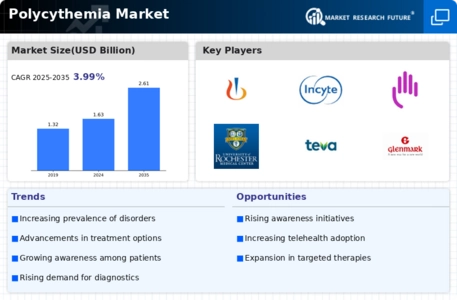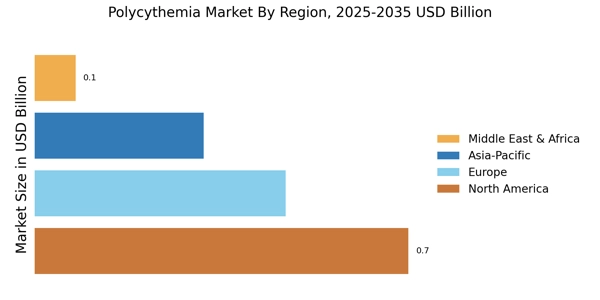Advancements in Treatment Modalities
Innovations in treatment options for polycythemia are significantly shaping the Polycythemia Market. Recent developments in targeted therapies and novel pharmacological agents have emerged, offering new hope for patients. For instance, the introduction of JAK2 inhibitors has transformed the management of polycythemia vera, providing effective alternatives to traditional therapies such as phlebotomy and myelosuppressive agents. The market for these advanced treatments is projected to grow, with estimates suggesting a compound annual growth rate of over 5% in the coming years. This growth is indicative of the increasing investment in research and development by pharmaceutical companies, aiming to enhance patient outcomes and expand treatment options within the Polycythemia Market.
Increasing Prevalence of Polycythemia
The rising incidence of polycythemia, particularly polycythemia vera, is a notable driver in the Polycythemia Market. Recent estimates indicate that the prevalence of this condition is increasing, with a reported incidence rate of approximately 2 to 3 cases per 100,000 individuals annually. This trend is likely influenced by factors such as aging populations and lifestyle changes, which may contribute to the development of hematological disorders. As more individuals are diagnosed, the demand for effective treatment options and diagnostic tools is expected to rise, thereby propelling growth within the Polycythemia Market. Furthermore, increased awareness among healthcare professionals and patients about the symptoms and risks associated with polycythemia is likely to lead to earlier diagnosis and intervention, further driving market expansion.
Technological Innovations in Diagnostics
Technological advancements in diagnostic tools are playing a pivotal role in the Polycythemia Market. The development of more sensitive and specific diagnostic tests, such as next-generation sequencing and advanced imaging techniques, is enhancing the ability to accurately diagnose polycythemia. These innovations not only facilitate early detection but also improve the monitoring of disease progression and treatment response. The market for diagnostic solutions is anticipated to expand, with a projected growth rate of approximately 6% over the next few years. This growth is driven by the increasing demand for precision medicine and personalized treatment approaches, which are becoming integral to the management of polycythemia. As diagnostic capabilities improve, the overall efficiency of the Polycythemia Market is likely to benefit.
Rising Awareness and Education Initiatives
The growing awareness surrounding polycythemia and its implications is a crucial driver for the Polycythemia Market. Educational initiatives aimed at both healthcare providers and the general public are becoming more prevalent, leading to improved understanding of the disease. Campaigns focusing on the symptoms, risks, and management of polycythemia are likely to encourage individuals to seek medical advice sooner. This proactive approach can result in earlier diagnosis and treatment, which is essential for effective disease management. As awareness increases, the demand for diagnostic tests and treatment options is expected to rise, thereby positively impacting the Polycythemia Market. Furthermore, collaborations between healthcare organizations and patient advocacy groups are likely to enhance outreach efforts, further driving market growth.
Growing Investment in Research and Development
The surge in investment in research and development within the field of hematology is a significant driver for the Polycythemia Market. Pharmaceutical companies and research institutions are increasingly focusing on understanding the underlying mechanisms of polycythemia and exploring novel therapeutic targets. This heightened investment is expected to yield new treatment options and improve existing therapies, thereby enhancing patient care. Recent reports indicate that funding for hematological research has increased by over 10% in the past year, reflecting a commitment to advancing knowledge and treatment strategies. As more breakthroughs are achieved, the Polycythemia Market is likely to experience substantial growth, driven by the introduction of innovative therapies and improved patient outcomes.


















Leave a Comment